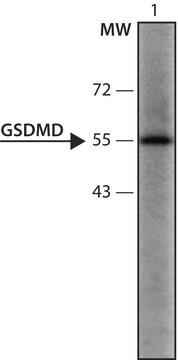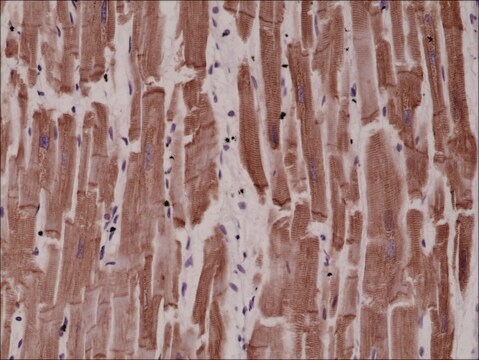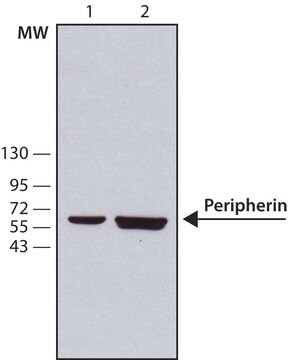推荐产品
生物源
mouse
共軛
unconjugated
抗體表格
purified from hybridoma cell culture
抗體產品種類
primary antibodies
無性繁殖
pδ, monoclonal
形狀
buffered aqueous solution
分子量
antigen ~80 kDa by SDS-PAGE
物種活性
human
濃度
~1.5 mg/mL
技術
immunocytochemistry: suitable
microarray: suitable
western blot: 1-2 μg/mL using HeLa nuclear extract
同型
IgG1
UniProt登錄號
運輸包裝
dry ice
儲存溫度
−20°C
目標翻譯後修改
unmodified
基因資訊
human ... COIL(8161)
一般說明
Monoclonal Anti-Coilin (mouse IgG1 isotype) is derived from the pδ hybridoma produced by the fusion of mouse myeloma cells and splenocytes from mice immunized with coilin. Coilin contains two nuclear localization sequences (NLS) (at amino acid 107-112 and 181-198) and several serine residues that are phosphorylated in vivo. The description of specific intranuclear structures known today as Cajal bodies was first published in 1903 by the neuro-cytologist Ramon-γ-Cajal who discovered that neurons contained spherical structures of around 0.5 μm in diameter that were often associated with nucleoli, nucleolar accessory bodies. It was found that patients with auto-antibodies against coiled bodies recognize a protein of 80 kDa termed p80-coilin. Nuclear antigens shown to colocalize with p80 coilin in Cajal bodies include basal transcription factors, cell cycle factors (cdks), splicing snRNPs and nucleolar factors including snoRNP.
特異性
The antibody recognizes the C-terminal region of human coilin and does not recognize mouse coilin.
免疫原
C-terminal (389 amino acids) human coilin
應用
Monoclonal Anti-Coilin antibody produced in mouse has been used in:
- immunoblotting
- immunocytochemistry
- cell microinjection
- fluorescence imaging
- indirect immunofluorescence
生化/生理作用
Mutating Serine-202 to Aspartate causes the disappearance of coiled bodies and a redistribution of coilin to intranucleolar domains. Coilin plays a key role in ribonucleoprotein and Cajal body formation.
外觀
Supplied as a solution in 0.01 M phosphate buffered saline, pH 7.4, and 15 mM sodium azide.
免責聲明
Unless otherwise stated in our catalog or other company documentation accompanying the product(s), our products are intended for research use only and are not to be used for any other purpose, which includes but is not limited to, unauthorized commercial uses, in vitro diagnostic uses, ex vivo or in vivo therapeutic uses or any type of consumption or application to humans or animals.
未找到合适的产品?
试试我们的产品选型工具.
儲存類別代碼
12 - Non Combustible Liquids
水污染物質分類(WGK)
nwg
閃點(°F)
Not applicable
閃點(°C)
Not applicable
Cajal bodies and coilin?moving towards function
Ogg SC and Lamond AI
The Journal of cell biology, 159(1), 17-21 (2002)
F Almeida et al.
The Journal of cell biology, 142(4), 899-912 (1998-08-29)
The coiled body is a distinct subnuclear domain enriched in small nuclear ribonucleoprotein particles (snRNPs) involved in processing of pre-mRNA. Although the function of the coiled body is still unknown, current models propose that it may have a role in
P68 RNA helicase (DDX5) alters activity of cis-and trans-acting factors of the alternative splicing of H-Ras
Camats M, et al.
Testing, 3(8), e2926-e2926 (2008)
Coilin: The first 25 years
Machyna M, et al.
RNA Biology, 12(6), 590-596 (2015)
Gall, J.G.
Annual Review of Cell Biology, 16, 273-273 (2000)
我们的科学家团队拥有各种研究领域经验,包括生命科学、材料科学、化学合成、色谱、分析及许多其他领域.
联系技术服务部门






![2-[1-[(2RS)-2-(2,4-Dichlorophenyl)-2-[[(2,4-dichlorophenyl)methyl]oxy]ethyl]-1H-imidazol-3-ium-3-yl]-2-methylpropanoate certified reference material, TraceCERT®, Manufactured by: Sigma-Aldrich Production GmbH, Switzerland](/deepweb/assets/sigmaaldrich/product/structures/481/128/d91bd82f-cdfa-4c75-adf1-b832d5b28606/640/d91bd82f-cdfa-4c75-adf1-b832d5b28606.png)